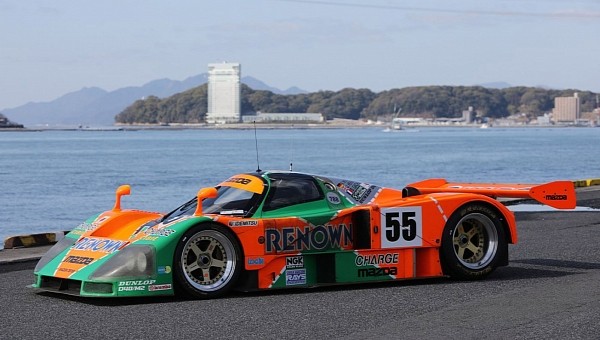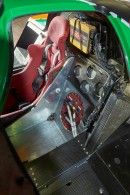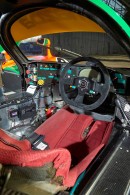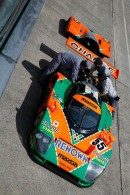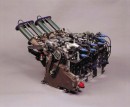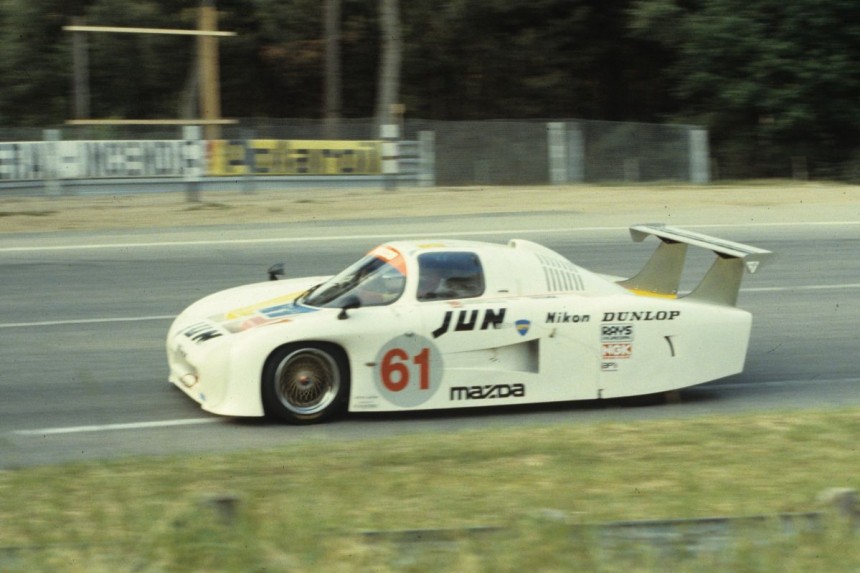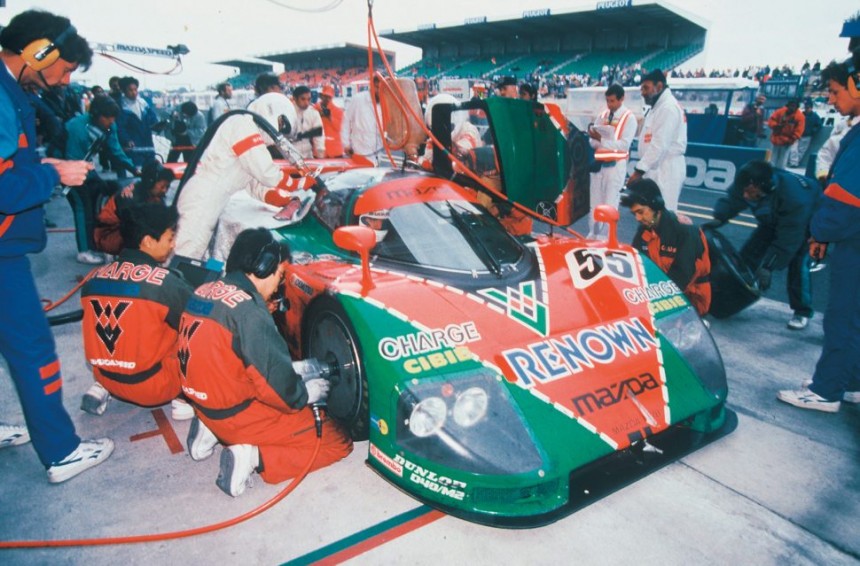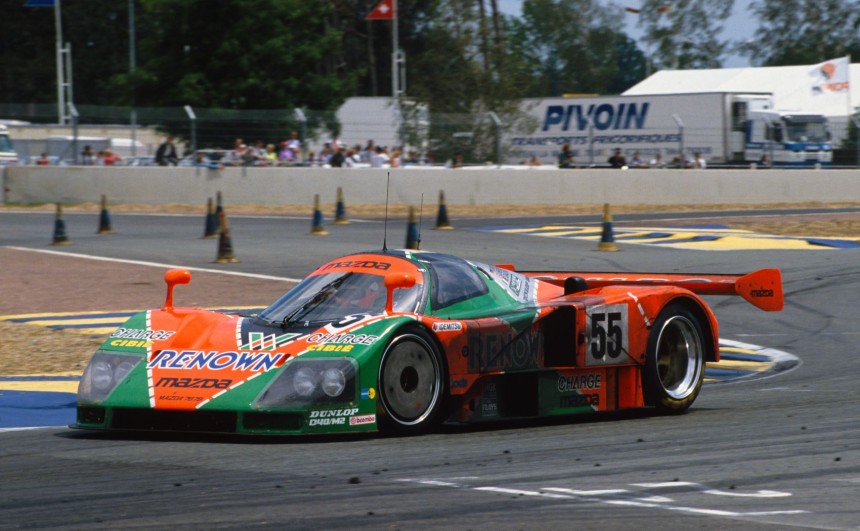The Mazda 787B is one of history's most legendary motorsport cars. The 787B is extremely important for the Japanese car culture and industry because it represents Japan's first Le Mans win.
By the early 1990s, Japanese car manufacturers had become a dominant force in the world of motorsport. They had great success in Formula 1 with the incredible Honda engine used by the McLaren team. In addition, they were having great results in rallying because from 1993 to 2000, a Japanese team was winning the World Manufacturers' Championship. Whether it was Toyota with their Celica and Corolla models, Subaru with the Impreza, or Mitsubishi with the Lancer Evo models, those three brands were destroying the competition. At one moment, only the Japanese were actually competing. And I don't even want to start talking about MotoGP, because Honda, Yamaha, and Suzuki dominated everything and everyone.
However, one event eluded them: the 24 Hours of Le Mans, one of motorsport's most prestigious and challenging races. No Japanese manufacturer had ever won this event, but that all changed in 1991, when the Mazda 787B crossed the line in first place. It wasn't only the first Japanese car to do so, but the only rotary-powered vehicle in history to win.
Because endurance racing is so tough (as a type of competition where you need to travel the longest distance to win, instead of completing a precise number of kilometers/miles in the shortest time), manufacturers used it to show off their technologies. One of those automotive companies was Mazda, a relatively small brand at that time based out in Hiroshima. During the 1960s, Mazda wanted to set itself apart from other Japanese automakers. Instead of concentrating on regular piston engines, they decided to put their effort behind a power unit created by Felix Wankel. His engine was totally different from a conventional piston powerplant. It had no piston or cylinders, just a big rotor that spun.
The benefit of this design was they could be built lighter and more compact than traditional power units, which was a significant plus for small Japanese motor vehicles. In order to prove that their design was better and more reliable than the competition, Mazda decided to enter one of the hardest possible tests in Europe, the 84-Hour Marathon de la Route, at the legendary Nurburgring circuit. They used two mostly stock Mazda Cosmos that were detuned to improve reliability. For much of the race, the two Cosmo models ran together in fourth and fifth. However, at the 82nd hour, one car had to retire due to axial damage, while the other managed to cross the finish line in P4.
The success at Nurburgring encouraged Mazda to compete in more motorsport events with rotary-powered cars. The Mazda Sports Corner racing team participated in numerous events in Japan and abroad. As a result, the Japanese manufacturer saw the potential to go further, so in 1983 they brought Mazda Sports Corner back to Hiroshima, where it became known as Mazdaspeed.
Throughout the 1980s, they entered a number of different prototype racing cars (like the 717 and 767B) into endurance races, including the 24 Hours of Le Mans. For the 1990 endurance racing calendar, Mazda introduced the 787. The design of the vehicle was created by Nigel Stroud, who, instead of making something completely new, used mechanical elements from a 767B with a few notable exceptions. The Japanese brand added new variable-length intakes, three spark plugs per rotor instead of two, carbon fiber apex seals, and many more. The engine layout was the same, but it had some notable additions.
This resulted in a power unit that could produce as much as 900 hp (913 ps). Still, to improve reliability, Mazda limited all this power to around 700 hp (710 ps). Another modification made was to relocate the radiators from the original place (besides the cockpit) to a single radiator fitted in the nose. Air moved from the front of the car underneath the bodywork and through the radiator before exiting right in front of the windshield. The sidepods were also included to assist in the engine (fitted in the rear of the car) and brakes cooling.
The 787 monocoque design was manufactured from carbon and kevlar. When the body was finished in the UK, it was sent to Japan for the final assembly. The new model was completed just in time for the second round of the Japanese Prototype Championship at the Fuji Speedway. After that, the second 787 model was finished, so the Mazdaspeed team departed for Europe, where former F1 winner Jacky Ickx was hired to prepare the squad and the vehicles.
For the 1990 24 Hours of Le Mans, the Japanese brand entered three cars, two being 787, while the third was an older 767B model. Unfortunately, the two 787 had to retire from the race, while the third car finished in P20. The Japanese engineers believed that heat from the engine caused both failures. After Le Mans, Mazda returned to Japan and began preparations for the following year. In 1991, they entered two 787 in the All Japan Sports Prototype Championship (JSPC), while the third car ran full-time in the FIA Sportscar World Championship.
A crucial decision that helped immensely was putting the French Oreca team in charge of the world championship campaign. This would prove to be pivotal as they and Jacky Ickx managed to persuade the FIA to declare that the 787B should be allowed to run at 830 kg (1,830 lb) instead of the 1000 kg minimum weight limit for the other vehicles.
Along with expanding their team, Mazdaspeed also worked on a number of improvements for the 787, later labeled the 787B. One of the most significant improvements made was to the intake system. Now the 787B had continuously variable intake runners increasing the torque to 448 lb-ft (608 Nm). The suspension geometry was changed, allowing for larger-diameter wheels and new ceramic carbon brakes.
For the 1991 race, Mazda entered the 24 Hours of Le Mans with three cars once again, two 787B and one 787. The new year came with a new set of rules because the FIA wanted the teams to use new 3.5-liter engines. While other teams were developing those engines, they had reliability problems. As a result, they were using older, but more reliable Group C cars. The only squad that managed to qualify with a new vehicle was Peugeot. Teams with 3.5-liter cars lined up in the first ten grid places, while the Mazdas started on the 19th, 23rd, and 30th.
On the day of the race, Mazda's team manager (known for his conservative strategies) instructed the drivers to go flat out because he saw how reliable and fuel-efficient the 787B was during testing. In the race's early stages, this new flat-out strategy paid off because the bright orange and green number 55 made its way up to third place. The Mazda cars were running well, but they would need a bit of luck if they wanted to win the race.
The first bit of luck was when the number 11 Mercedes C11 spun off the track and later pitted with gearbox issues, putting the 787B in second place. The other Mercedes (who was leading the race) was slowing down to preserve its fuel, and Mazda (more reliable and fuel-efficient) had a big chance of winning this event. At the 22nd hour, number 55 took the lead after the C11 was forced to pit due to mechanical problems. At the last pit stop for Mazda, Johnny Herbert asked to stay in the car and crossed the finish line first, making the 787B the first Japanese car and the only rotary-powered car to win the 24 Hours of Le Mans.
After the event, the winning car was retired from racing, while a new 787B continued to compete in Japanese and world championships. Unfortunately, this model could not repeat the success of Le Mans, coming fifth overall in the World Endurance Championship. Due to new rules for the 1992 season, rotary cars could not make an entry, and they would ultimately be retired from racing.
In our era, the 787B is considered to be one of the most iconic and legendary race cars, and it will forever be remembered for its surprising result at the prestigious event.
However, one event eluded them: the 24 Hours of Le Mans, one of motorsport's most prestigious and challenging races. No Japanese manufacturer had ever won this event, but that all changed in 1991, when the Mazda 787B crossed the line in first place. It wasn't only the first Japanese car to do so, but the only rotary-powered vehicle in history to win.
Because endurance racing is so tough (as a type of competition where you need to travel the longest distance to win, instead of completing a precise number of kilometers/miles in the shortest time), manufacturers used it to show off their technologies. One of those automotive companies was Mazda, a relatively small brand at that time based out in Hiroshima. During the 1960s, Mazda wanted to set itself apart from other Japanese automakers. Instead of concentrating on regular piston engines, they decided to put their effort behind a power unit created by Felix Wankel. His engine was totally different from a conventional piston powerplant. It had no piston or cylinders, just a big rotor that spun.
The benefit of this design was they could be built lighter and more compact than traditional power units, which was a significant plus for small Japanese motor vehicles. In order to prove that their design was better and more reliable than the competition, Mazda decided to enter one of the hardest possible tests in Europe, the 84-Hour Marathon de la Route, at the legendary Nurburgring circuit. They used two mostly stock Mazda Cosmos that were detuned to improve reliability. For much of the race, the two Cosmo models ran together in fourth and fifth. However, at the 82nd hour, one car had to retire due to axial damage, while the other managed to cross the finish line in P4.
Throughout the 1980s, they entered a number of different prototype racing cars (like the 717 and 767B) into endurance races, including the 24 Hours of Le Mans. For the 1990 endurance racing calendar, Mazda introduced the 787. The design of the vehicle was created by Nigel Stroud, who, instead of making something completely new, used mechanical elements from a 767B with a few notable exceptions. The Japanese brand added new variable-length intakes, three spark plugs per rotor instead of two, carbon fiber apex seals, and many more. The engine layout was the same, but it had some notable additions.
This resulted in a power unit that could produce as much as 900 hp (913 ps). Still, to improve reliability, Mazda limited all this power to around 700 hp (710 ps). Another modification made was to relocate the radiators from the original place (besides the cockpit) to a single radiator fitted in the nose. Air moved from the front of the car underneath the bodywork and through the radiator before exiting right in front of the windshield. The sidepods were also included to assist in the engine (fitted in the rear of the car) and brakes cooling.
The 787 monocoque design was manufactured from carbon and kevlar. When the body was finished in the UK, it was sent to Japan for the final assembly. The new model was completed just in time for the second round of the Japanese Prototype Championship at the Fuji Speedway. After that, the second 787 model was finished, so the Mazdaspeed team departed for Europe, where former F1 winner Jacky Ickx was hired to prepare the squad and the vehicles.
A crucial decision that helped immensely was putting the French Oreca team in charge of the world championship campaign. This would prove to be pivotal as they and Jacky Ickx managed to persuade the FIA to declare that the 787B should be allowed to run at 830 kg (1,830 lb) instead of the 1000 kg minimum weight limit for the other vehicles.
Along with expanding their team, Mazdaspeed also worked on a number of improvements for the 787, later labeled the 787B. One of the most significant improvements made was to the intake system. Now the 787B had continuously variable intake runners increasing the torque to 448 lb-ft (608 Nm). The suspension geometry was changed, allowing for larger-diameter wheels and new ceramic carbon brakes.
For the 1991 race, Mazda entered the 24 Hours of Le Mans with three cars once again, two 787B and one 787. The new year came with a new set of rules because the FIA wanted the teams to use new 3.5-liter engines. While other teams were developing those engines, they had reliability problems. As a result, they were using older, but more reliable Group C cars. The only squad that managed to qualify with a new vehicle was Peugeot. Teams with 3.5-liter cars lined up in the first ten grid places, while the Mazdas started on the 19th, 23rd, and 30th.
The first bit of luck was when the number 11 Mercedes C11 spun off the track and later pitted with gearbox issues, putting the 787B in second place. The other Mercedes (who was leading the race) was slowing down to preserve its fuel, and Mazda (more reliable and fuel-efficient) had a big chance of winning this event. At the 22nd hour, number 55 took the lead after the C11 was forced to pit due to mechanical problems. At the last pit stop for Mazda, Johnny Herbert asked to stay in the car and crossed the finish line first, making the 787B the first Japanese car and the only rotary-powered car to win the 24 Hours of Le Mans.
After the event, the winning car was retired from racing, while a new 787B continued to compete in Japanese and world championships. Unfortunately, this model could not repeat the success of Le Mans, coming fifth overall in the World Endurance Championship. Due to new rules for the 1992 season, rotary cars could not make an entry, and they would ultimately be retired from racing.
In our era, the 787B is considered to be one of the most iconic and legendary race cars, and it will forever be remembered for its surprising result at the prestigious event.
